Woodruff Sleeping and Parlor Coach Company (Signed by Daniel Chase Corbin)
- Guaranteed authentic document
- Orders over $75 ship FREE to U. S. addresses
Product Details
Company
Woodruff Sleeping and Parlor Coach Company
Certificate Type
Mortgage and Sinking Fund Bond
Date Issued
March 1, 1888
Canceled
No
Printer
Homer Lee Bank Note Company
Signatures
Hand signed
Approximate Size
9 1/2" (w) by 14 1/2" (h)
Images
Representative of the piece you will receive
Guaranteed Authentic
Yes
Additional Details
Signed by Daniel Chase Corbin
Reference
Historical Context
At the age of 16, Theodore Tuttle Woodruff (1811-1892) happily left the farm and became an apprentice wagon-maker. He worked at that trade for three years and then went into a foundry to learn pattern-making. As a journeyman pattern-maker he worked for the earliest car builders in Springfield, MA. He may have worked at Dean, Packard & Mills Car Builders in Springfield and thus had a friendship with Caleb Parker at the time Parker was a principal in Barney, Parker & Company (predecessor to Barney & Smith).

About 1855, Woodruff became Master Car Builder for the Terre Haute, Alton & St. Louis Railroad at Alton, IL. At the time of his employment, Barney, Parker & Co. was engaged to build cars for that railroad. On December 2, 1856, Woodruff received two patents for a convertible car seat (Nos. 16,159 and 16,160). He went back to Springfield, MA, where he had a car built by T.W. Wason & Co. using the seats.
Woodruff's design divided the car into sections, with seats permanently fixed in pairs facing each other. A lower and a middle berth were produced by a complicated arrangement of pivoted seat cushions. An upper was produced by hinged frames that folded up against the wall by day. At night curtains were hung between and in front of the berths.
Woodruff’s car was tried on the New York Central in 1858, with Woodruff personally managing it. While there, he met Andrew Carnegie, who sent him to see T.A. Scott, superintendent of the Pennsylvania Railroad, who encouraged Woodruff to organize a company to build and operate the cars. Woodruff organized T.T. Woodruff & Company, and Carnegie, of course, was one of the investors. The Woodruff car was withdrawn from the NYC and adopted by the Pennsylvania Railroad for use on its run between Pittsburgh and Philadelphia. It met with considerable success, and by the end of 1858 eight of the midwestern railroads had Woodruff cars in service. Barney, Parker & Company was engaged to build some of Woodruff’s patented sleeping cars.
The Central Transportation Company was established in 1862, with Woodruff as the principal stockholder and his brother Jonah (1809-1876) as manager. Woodruff assigned his patents to the new company, as did several other inventors. But in 1864 Woodruff assigned all his interests to one of the other stockholders and retired from the sleeping car business.
Woodruff was an inveterate mechanic, inventor and promoter. Among his inventions -- besides the sleeping car apparatus -- were a coffee-hulling machine, a surveyor's compass and a steam plow. He was killed in 1892 when -- at the ripe old age of 81 -- he was struck by a train while on a business trip to promote his new method of propelling ships.
In 1870, Central Transportation became involved with Pullman in a patent infringement suit and after costly litigation was leased to, and assigned most of its patent rights to, the Pullmans Palace Car Company.
Theodore Woodruff’s brother Jonah decided to begin again and organize his own line. He had been involved in sleeping car design and had acquired several patents of his own. His new company -- the Woodruff Sleeping & Parlor Coach Company. -- was expanding nicely when his health gave way in the mid-1870s, and he died in 1876.
The December 1888 issue of the Official Railway Guide startled the railroad world (and most of all George M. Pullman) with this announcement: "Union Palace Car Co.... will commence operating SLEEPING AND PARLOR CARS on about 15,000 miles of railroad in January 1889." Formed by Job H. Jackson of Jackson & Sharp, Union Palace Car Co. was in effect a consolidation of Woodruff Sleeping & Parlor Coach Co. and Mann Boudoir Car Co. These two companies operated a total of 34 cars on about 5,000 miles of railroads in the East, South, and Midwest. Pullman lost no time. Two months later Union Palace was purchased by Pullmans Palace Car Company for $2.5 million. Some parts of Union seem to have survived, because it was not finally dissolved until 1899.
Daniel Chase Corbin

Daniel Chase Corbin's Signature
Mining and railroad magnate Daniel Chase Corbin ranks as a major shaper of the growth and prosperity of Spokane, Washington - the economic and geographic center of the Inland Northwest. He settled in Spokane in 1889, already an experienced Western entrepreneur and well positioned to survive the Panic of 1893, which depleted the fortunes of Spokane's earliest tycoons. The bulk of Corbin's wealth was based on his railroads that stitched the Idaho Panhandle and British Columbia Kootenay mines to Spokane.
Over the years, he was substantially involved in other enterprises as diverse as banking, real estate, irrigation, beet sugar production, and coal mining. Corbin often was pointed out as Spokane's richest man as he passed in his buggy, its superb team driven at top speed by a coachman. But unlike many of his wealthy predecessors and contemporaries, Corbin was not a civic leader or benefactor, at least in any obvious way, and, upon his death, his wealth remained with his descendants. His personal and family life was full of enigmas, and his aloof demeanor did not make him popular in the community. Furthermore, his secretiveness about earnings and assets would not be allowed under today's business regulations. Yet Corbin's contribution to his adopted city was massive, his railroads and other ventures enabling such wealth to pour into Spokane that, during his time, it became the hub of the "Inland Empire."
Related Collections
Additional Information
Certificates carry no value on any of today's financial indexes and no transfer of ownership is implied. All items offered are collectible in nature only. So, you can frame them, but you can't cash them in!
All of our pieces are original - we do not sell reproductions. If you ever find out that one of our pieces is not authentic, you may return it for a full refund of the purchase price and any associated shipping charges.









